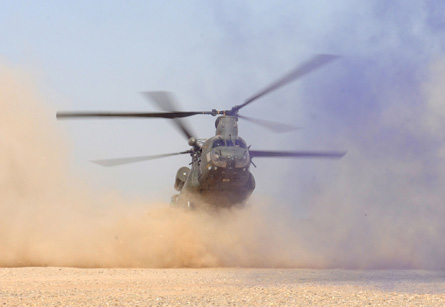BAE Systems believes it has cracked a persistent problem facing operators of military helicopters around the globe: how to enable pilots to maintain situational awareness in degraded visual environments, such as brownout, fog and smoke.
The company's brownout landing aid system technology, or Blast, uses a millimetre-wave radar seeker to scan a landing zone in real time, in combination with digital terrain elevation data. Pilots receive situational information and warnings of obstacles via a brownout symbology set shown using a cockpit, head-up or helmet-mounted display.
Originally developed for European missile manufacturer MBDA's Brimstone air-to-surface missile, the 94 GHz seeker is housed within a 7in-diameter aperture and will weigh just 4.5-6.8kg (10-15lb) for a production system, said Paul Cooke, BAE's business development director of defence avionics.
 |
|---|
© Sgt Dan Harmer/Ministry of DefenceMilitary helicopter operators have recorded a high accident rate in Afghanistan and Iraq, due to the dusty conditions encountered while landing |
Including its one supporting line-replaceable unit and associated wiring, the entire Blast system will have an installed weight of just 13.6-15.9kg.
"That's a much lighter weight than competing systems," said Cooke, referring to current designs which rely on laser radar technology.
As a result, as well as being suitable for use by transports such as the Boeing CH-47 Chinook, Sikorsky CH-53 and Bell Boeing V-22, Blast could also be integrated with small types, like the Boeing AH-6 Little Bird, he said.
The US military in particular has encountered a high accident rate during operations in Afghanistan and Iraq, due to the dusty conditions encountered while landing.
"It's clearly not a training or experience issue, but a technology one," Cooke said at the Defence & Security Equipment International (DSEi) exhibition in London on 13 September. "We have got it in the right size and weight, and with the right maturity."
Flight tests, sponsored by bodies including the US Air Force Research Laboratory, US Army and US Defense Advanced Research Projects Agency, have to date included a two-week campaign at the Yuma Proving Grounds in Arizona in April.
Performed using a Bell UH-1 testbed, these "demonstrated effective real-time 3D visual landing zone representation with overlaid flight symbology information to a pilot in degraded visual environment conditions," BAE said. "This allowed the pilot to easily judge the height, speed and drift of the aircraft." Another series of tests will commence around late September.
Cooke said BAE could be in a position to launch low-rate initial production of the Blast system around late 2013, but added: "with customer interest we could accelerate that".
Initial users for the system could be from the combat search and rescue and special operations communities, with wider applications to follow for both new-build and in-service aircraft.
"Our flight tests have been very well observed by multiple agencies," Cooke said. "We're confident that someone will go forward with the programme."
- All the latest news, video and images from DSEi 2011
Source: Flight International























